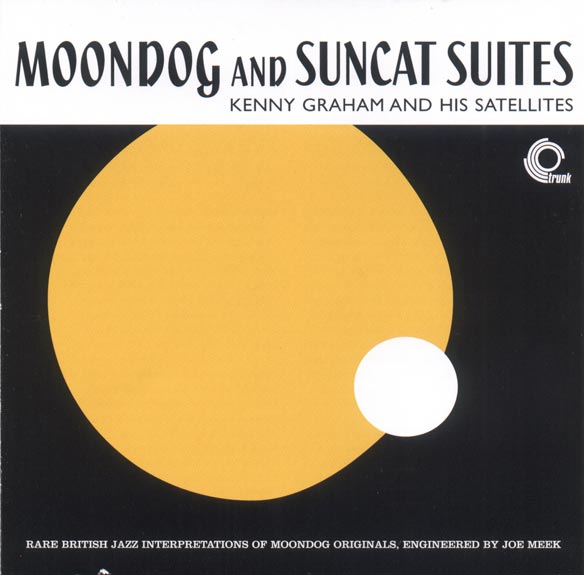

|
 Sound Sound UbuWeb UbuWeb |
Kenny Graham Moondog and Suncat Suites (1957) Kenny Graham and his Satellites Moondog Suite 1) One Four 2) 2 West 46th Street 3) Two four 4) Chant 5) Three Four 6) Utsu 7) Four four 8) Lullaby 9) Five four 10) Fog On The Hudson Suncat Suite 11) Sunrise 12) Sunbeam 13) Tropical Sun 14) Sunstroke 15) Sunset 16) Sunday 
NOTES Original Sleevenotes from the 1957 HMV release. Walking along the streets surrounding New York City's Broadway -- Times Square area late of an evening, strollers often encounter a tall, monk-like figure of ageless quality. The man is blind and he uses a long stave, like a shepherd of Biblical times, to find his way. Though the night might be cold, his feet are usually encased solely in sandals. His body is wrapped in a flowing robe fashioned from rough, brown blankets. His bearded face bears a gentle, haunting look. The man is the world-famous Moondog, poet, philosopher, mendicant, musician extraordinaire. Moondog is the son of missionary parents and grew up on an Indian reservation in the West. A highly-trained musician, he has an extraordinary knowledge of serious classical music as well as of jazz and ethnic music. He has written provocative symphonic scores and he has penned "pop" melodies. Friends of his will tell you that his blanket garments are filled with cunningly-fashioned pockets very much like cubby-holes and that these pockets bulge with musical scores. His interest in primitive music has drawn him to fashion strange, beautiful instruments of his own designing -- whistles and flutes and percussion instruments of unusual timbres. And these, too, fill the pockets of his robe or hang from it by chords, ready for his use in impromptu, street-corner concerts. Inevitably, too, there is his contribution box, an object he once described to a reporter for a New York newspaper as "the only instrument that really keeps me alive." Moondog is a modern bard or minstrel, a musician who travels from crowd to crowd making spontaneous music for whatever the listener might care to pay for his entertainment. Usually, his street-corner music is improvised. He listens to the sounds around him -- traffic noises, a lonely fog horn bleating wearily from the river. The rumble of a subway train under the street, the sudden drone of an airplane overhead -- and these sounds form the basis of the piece he proceeds to create on the spot. His performing gifts are as phenomenal as they are virtuosic and colourful. He uses his hands and feet all at once with his percussion instruments, setting two and three and four rhythms going simultaneously and contrapuntally. He sometimes takes his titles for pieces from the locale -- the address on the doorway nearby (2 West 46th Street) -- or from the atmosphere (Fog On The Hudson). Almost any night in mid-town New York, as you wander around, you'll encounter Moondog -- and the night around him is filled with startling, spellbinding, imaginative music. A few years ago, some recordings of a Moondog street-corner concert were made. A tape machine and a microphone were set up right there on the sidewalk and Moondog played away in inspired fashion. You might remember the recordings -- they caused quite a stir in jazz circles and many a "serious" musician was attracted to them too. These recordings travelled far -- among other places to England. And, there, they attracted the attention of the noted British jazzman, Kenny Graham. Graham was fascinated by what he heard -- whole new worlds of rhythm and tonal colourings seemed to open to his mind and ear. It was then that he decided to translate the music of Moondog to the more orthodox instruments you might encounter in a jazz combo of progressive design. Not too Orthodox, however. In both sides of this recording you'll find such instruments and combinations of instruments as vibraphone, xylophone, marimba, celeste. tubular bells, Egyptian cymbals, flue, oboe, bass clarinet, accordion and "instrumentalizing" voice. The voice belongs to the Ceylonese singer, Yolanda. The result of Graham's labour is the provocative "Moondog Suite". Graham's arrangements of Moondog's original material are wonderfully idiomatic, excitingly accurate in capturing the spontaneity and vigour that had first attracted him. And the arrangements are performed superbly in this recording by some of Britain's top instrumentalists. To complement the unique "Moondog Suite", Kenny Graham has created a suite of his own, inspired by some of the techniques of Moondog. To his delightfully imaginative composition he has applied the not inappropriate title "Suncat Suite". Again, here, we enter something of a bright, evocative new world of jazz: one teeming with original instrumental colours and effects, with sharp, new rhythms, and striking, meaningful ideas. "Moondog Suite" and "Suncat Suite" are companion pieces that fit together with exciting perfection. You'll find them rich, lastingly- entertaining listening. Kenny Graham One of Britain's foremost jazz composers and arrangers; a large red-bearded, soft voiced, strong man with a penchant for spending the greater part of his free time in a loose sweater refusing to conform. Mint example of that rare character, the artist who really does have talent but who genuinely refuses to have any truck with commercialism or to write anything bad just because it pays well. Mercurial temperament which ideally suits almost surrealist life he leads in Soho and elsewhere. Born July 19th --"At eight O'clock on a Saturday morning: the earliest I ever got up," says Kenny. The Personnel: Kenny Graham (tenor, percussion, whistle) Stan Tracey (piano, vibes, accordion, celeste) Phil Seamen (drums, percussion) Ivor Slaney (oboe) Sammy Stokes (bass) Don Lawson (percussion, drums) Danny Moss (bass clarinet) Jack Ellory (flute) Eddie Taylor (Percussion) Martin Slavin (xylo, marimba, vibes) Sammy Stokes (bass) Vic Ash (clarinet) Yolanda (vocals) Recorded between 02.07.56 and 11.07.56 Engineer on all sessions JOE MEEK |